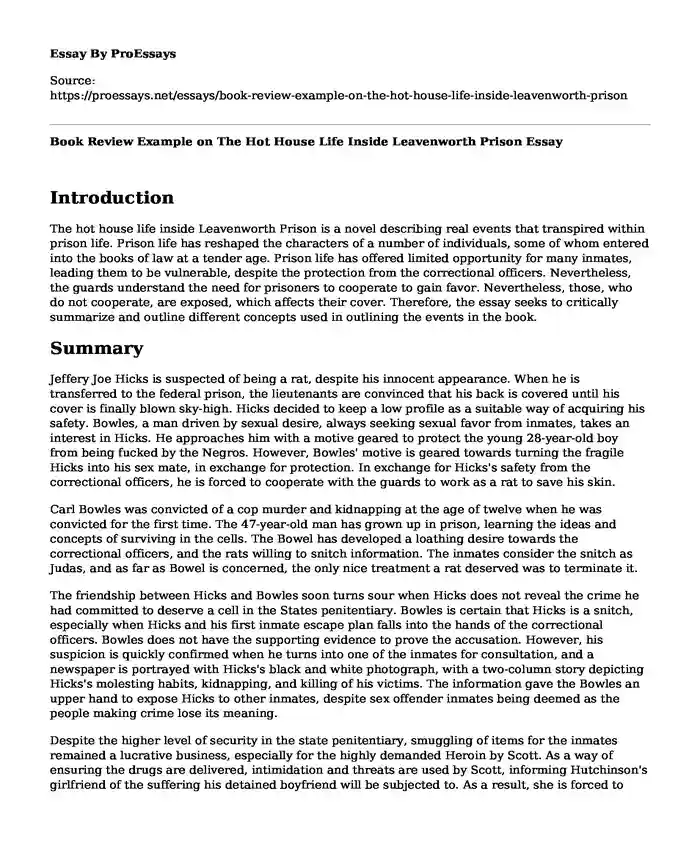Introduction
The hot house life inside Leavenworth Prison is a novel describing real events that transpired within prison life. Prison life has reshaped the characters of a number of individuals, some of whom entered into the books of law at a tender age. Prison life has offered limited opportunity for many inmates, leading them to be vulnerable, despite the protection from the correctional officers. Nevertheless, the guards understand the need for prisoners to cooperate to gain favor. Nevertheless, those, who do not cooperate, are exposed, which affects their cover. Therefore, the essay seeks to critically summarize and outline different concepts used in outlining the events in the book.
Summary
Jeffery Joe Hicks is suspected of being a rat, despite his innocent appearance. When he is transferred to the federal prison, the lieutenants are convinced that his back is covered until his cover is finally blown sky-high. Hicks decided to keep a low profile as a suitable way of acquiring his safety. Bowles, a man driven by sexual desire, always seeking sexual favor from inmates, takes an interest in Hicks. He approaches him with a motive geared to protect the young 28-year-old boy from being fucked by the Negros. However, Bowles' motive is geared towards turning the fragile Hicks into his sex mate, in exchange for protection. In exchange for Hicks's safety from the correctional officers, he is forced to cooperate with the guards to work as a rat to save his skin.
Carl Bowles was convicted of a cop murder and kidnapping at the age of twelve when he was convicted for the first time. The 47-year-old man has grown up in prison, learning the ideas and concepts of surviving in the cells. The Bowel has developed a loathing desire towards the correctional officers, and the rats willing to snitch information. The inmates consider the snitch as Judas, and as far as Bowel is concerned, the only nice treatment a rat deserved was to terminate it.
The friendship between Hicks and Bowles soon turns sour when Hicks does not reveal the crime he had committed to deserve a cell in the States penitentiary. Bowles is certain that Hicks is a snitch, especially when Hicks and his first inmate escape plan falls into the hands of the correctional officers. Bowles does not have the supporting evidence to prove the accusation. However, his suspicion is quickly confirmed when he turns into one of the inmates for consultation, and a newspaper is portrayed with Hicks's black and white photograph, with a two-column story depicting Hicks's molesting habits, kidnapping, and killing of his victims. The information gave the Bowles an upper hand to expose Hicks to other inmates, despite sex offender inmates being deemed as the people making crime lose its meaning.
Despite the higher level of security in the state penitentiary, smuggling of items for the inmates remained a lucrative business, especially for the highly demanded Heroin by Scott. As a way of ensuring the drugs are delivered, intimidation and threats are used by Scott, informing Hutchinson's girlfriend of the suffering his detained boyfriend will be subjected to. As a result, she is forced to smuggle the drugs, acting as a mule to protect his boyfriend from being abused.
The past history of characters such as Carl Bowless defines why they found themselves locked behind bars. The prison files define Bowles's past history as a journey, where he was raised by his drunken father, a womanizing man that spent most of his time drinking. At the age of eight, Bowels was barely raising himself, a concept that may have reshaped him into a malevolent prisoner.
Reaction
The novel utilizes numerous concepts in describing the events that transpired in prison. For instance, violence has been characterized as a central theme within the first part of the story. As a result, this helps make the prison atmosphere, which is tense, making the readers follow the events critically. On the contrary, the book also outlines the traces of racism, especially when Hicks, a 28-years-man is transferred to the States prison. In the new prison, Bowles offers to protect him in exchange for protection from the blacks, which are described as Negros. As a result, this indicates the degree of racism depicted within the prison.
On the contrary, power, and control have been described in the book, indicating how the weaker inmates are converted into sex prays in exchange for their safety. Power and control indicate the increase in oppression, where the domination of power and security is an enjoyed privilege that a given group of gang members enjoy.
Conclusion
The Novel utilizes both soft and hard language that is used to describe the events that transpired in prison. As a result, they set the avenue for a ruthless and unforgiving environment. Moreover, the language has reshaped the characters and their behaviors. Some of the characters who find it cumbersome to cope with the prison system are forced to be observed, playing the critical role of informants to the correctional officers.
Cite this page
Book Review Example on The Hot House Life Inside Leavenworth Prison. (2023, Dec 18). Retrieved from https://proessays.net/essays/book-review-example-on-the-hot-house-life-inside-leavenworth-prison
If you are the original author of this essay and no longer wish to have it published on the ProEssays website, please click below to request its removal:
- McKinney Vento Act Annotated Bibliography
- Glenn Altschuler "All Shook Up: How Rock 'n' Roll Changed America" Essay
- Hamlet's Hamartia Essay
- Fathered by a White Landowner: Fredrick Douglass's Journey - Essay Sample
- Criminal Justice: Upholding Social Equality and Redressing Injustice - Research Paper
- Leadership in Antigone - Essay Sample
- Essay Example on Child Advocacy: Ensuring Justice for Youth in the US Justice System







